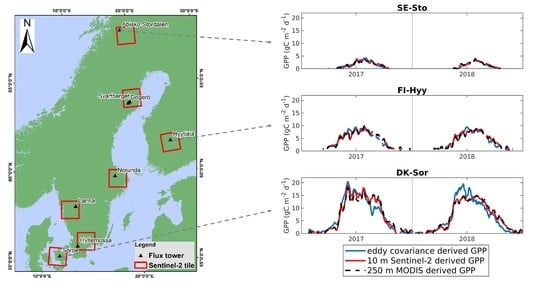Modelling Daily Gross Primary Productivity with Sentinel-2 Data in the Nordic Region–Comparison with Data from MODIS
Abstract
1. Introduction
2. Materials and Methods
2.1. Study Sites and Environmental Variables
2.2. Eddy Covariance Influence Area
2.3. Daily EVI2 Trajectories of Satellite Pixels
2.4. Daily EVI2 of Flux Footprint
2.5. Empirical Regression Models for GPP Estimation
3. Results
3.1. Relationships between GPP, EVI2 and Environmental Variables
3.2. Multiple Linear Regression Models of GPP
4. Discussion
4.1. Similar Performance of Sentinel-2 and MODIS on GPP Modelling
4.2. Challenges and Outlook
5. Conclusions
Author Contributions
Funding
Acknowledgments
Conflicts of Interest
Appendix A
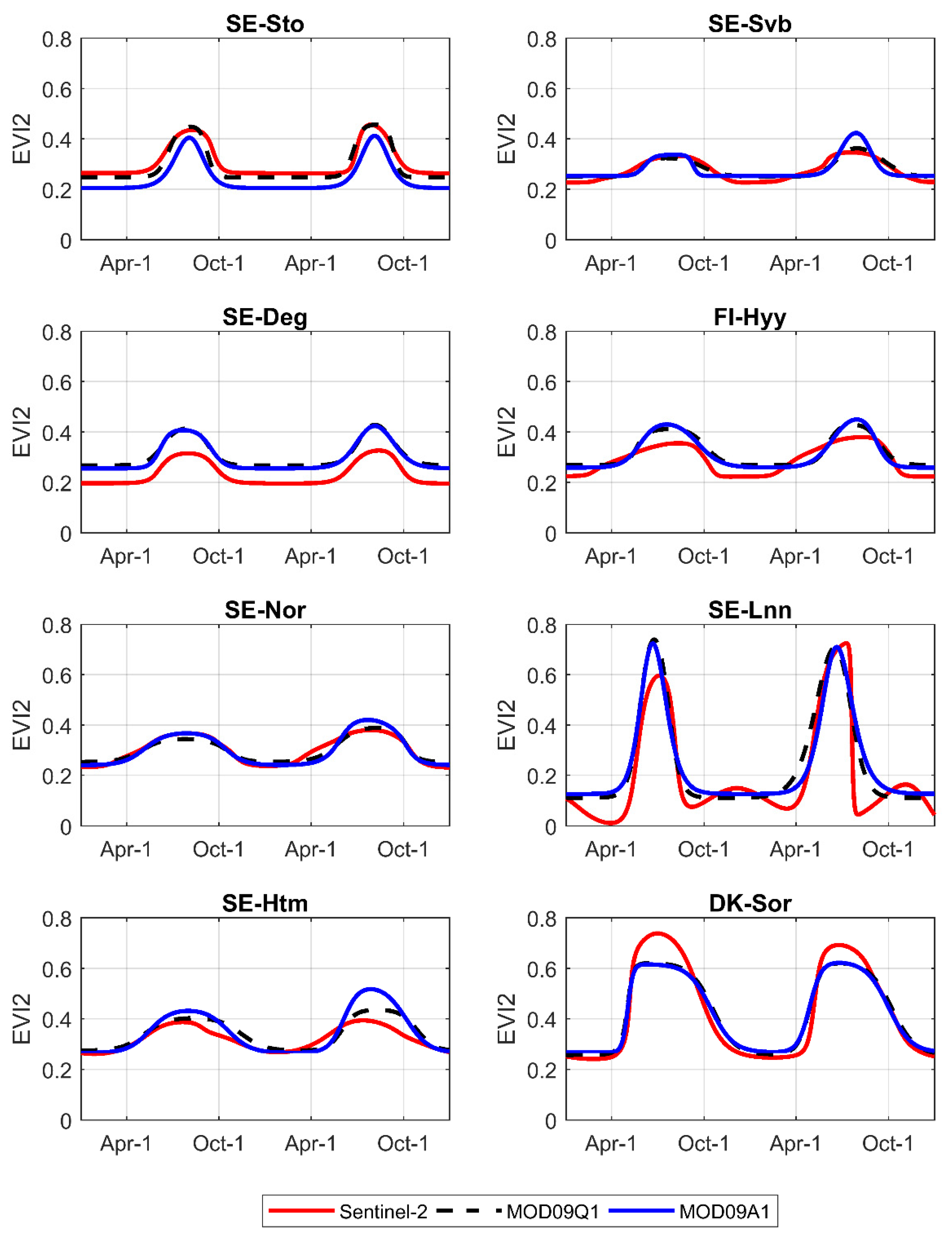
| Model I | Model II | Model III | ||||||||
|---|---|---|---|---|---|---|---|---|---|---|
| Resolution | RMSE | MAE | R2 | RMSE | MAE | R2 | RMSE | MAE | R2 | |
| SE-Sto | 10 m | 0.49 | 0.39 | 0.83 | 0.97 | 0.76 | 0.33 | 0.74 | 0.54 | 0.62 |
| 250 m | 0.45 | 0.35 | 0.86 | 0.95 | 0.73 | 0.37 | 0.73 | 0.54 | 0.62 | |
| 500 m | 0.44 | 0.35 | 0.86 | 0.93 | 0.72 | 0.39 | 0.71 | 0.53 | 0.64 | |
| SE-Svb | 10 m | 1.12 | 0.95 | 0.87 | 1.83 | 1.57 | 0.67 | 1.50 | 1.20 | 0.77 |
| 250 m | 1.10 | 0.94 | 0.88 | 1.80 | 1.55 | 0.68 | 1.49 | 1.20 | 0.78 | |
| 500 m | 1.04 | 0.88 | 0.89 | 1.76 | 1.52 | 0.69 | 1.48 | 1.20 | 0.78 | |
| SE-Deg | 10 m | 0.51 | 0.39 | 0.71 | 0.62 | 0.49 | 0.56 | 0.56 | 0.42 | 0.64 |
| 250 m | 0.52 | 0.40 | 0.69 | 0.65 | 0.52 | 0.52 | 0.58 | 0.44 | 0.61 | |
| 500 m | 0.51 | 0.40 | 0.70 | 0.63 | 0.50 | 0.55 | 0.57 | 0.44 | 0.62 | |
| FI-Hyy | 10 m | 0.98 | 0.73 | 0.89 | 1.76 | 1.39 | 0.65 | 1.01 | 0.78 | 0.88 |
| 250 m | 0.96 | 0.71 | 0.89 | 1.38 | 1.09 | 0.78 | 0.92 | 0.72 | 0.90 | |
| 500 m | 0.96 | 0.70 | 0.89 | 1.34 | 1.06 | 0.79 | 0.91 | 0.72 | 0.90 | |
| SE-Nor | 10 m | 1.27 | 1.02 | 0.84 | 1.36 | 0.97 | 0.81 | 1.21 | 0.95 | 0.85 |
| 250 m | 1.36 | 1.09 | 0.81 | 1.35 | 0.94 | 0.81 | 1.24 | 0.96 | 0.84 | |
| 500 m | 1.33 | 1.07 | 0.82 | 1.27 | 0.89 | 0.84 | 1.24 | 0.99 | 0.84 | |
| SE-Lnn | 10 m | 1.60 | 1.03 | 0.88 | 1.50 | 0.90 | 0.90 | 1.73 | 1.08 | 0.86 |
| 250 m | 1.60 | 1.19 | 0.88 | 1.33 | 1.02 | 0.92 | 1.47 | 0.98 | 0.90 | |
| 500 m | 1.96 | 1.43 | 0.82 | 1.56 | 1.14 | 0.89 | 1.77 | 1.19 | 0.85 | |
| SE-Htm | 10 m | 1.92 | 1.63 | 0.77 | 1.49 | 1.09 | 0.86 | 1.85 | 1.50 | 0.79 |
| 250 m | 2.13 | 1.83 | 0.72 | 1.36 | 0.97 | 0.88 | 1.84 | 1.48 | 0.79 | |
| 500 m | 2.09 | 1.81 | 0.73 | 1.29 | 0.93 | 0.90 | 1.81 | 1.46 | 0.79 | |
| DK-Sor | 10 m | 1.91 | 1.44 | 0.91 | 1.59 | 1.16 | 0.93 | 1.76 | 1.29 | 0.92 |
| 250 m | 2.19 | 1.68 | 0.88 | 1.95 | 1.37 | 0.90 | 1.79 | 1.28 | 0.92 | |
| 500 m | 2.12 | 1.63 | 0.88 | 1.96 | 1.39 | 0.90 | 1.78 | 1.29 | 0.92 | |
| Average | 10 m | 0.49 | 0.39 | 0.83 | 0.97 | 0.76 | 0.33 | 0.74 | 0.54 | 0.62 |
| 250 m | 0.45 | 0.35 | 0.86 | 0.95 | 0.73 | 0.37 | 0.73 | 0.54 | 0.62 | |
| 500 m | 0.44 | 0.35 | 0.86 | 0.93 | 0.72 | 0.39 | 0.71 | 0.53 | 0.64 | |
References
- Pachauri, R.K.; Allen, M.R.; Barros, V.R.; Broome, J.; Cramer, W.; Christ, R.; Church, J.A.; Clarke, L.; Dahe, Q.; Dasgupta, P. Climate Change 2014: Synthesis Report. Contribution of Working Groups I, II and III to the Fifth Assessment Report of the Intergovernmental Panel on Climate Change; IPCC: Geneva, Switzerland, 2014. [Google Scholar]
- Jung, M.; Reichstein, M.; Margolis, H.A.; Cescatti, A.; Richardson, A.D.; Arain, M.A.; Arneth, A.; Bernhofer, C.; Bonal, D.; Chen, J. Global patterns of land-atmosphere fluxes of carbon dioxide, latent heat, and sensible heat derived from eddy covariance, satellite, and meteorological observations. J. Geophys. Res. Biogeosci. 2011, 116. [Google Scholar] [CrossRef]
- Pan, Y.; Birdsey, R.A.; Fang, J.; Houghton, R.; Kauppi, P.E.; Kurz, W.A.; Phillips, O.L.; Shvidenko, A.; Lewis, S.L.; Canadell, J.G.; et al. A large and persistent carbon sink in the world’s forests. Science 2011, 333, 988–993. [Google Scholar] [CrossRef]
- Graven, H.D.; Keeling, R.F.; Piper, S.C.; Patra, P.K.; Stephens, B.B.; Wofsy, S.C.; Welp, L.R.; Sweeney, C.; Tans, P.P.; Kelley, J.J.; et al. Enhanced seasonal exchange of CO2 by northern ecosystems since 1960. Science 2013, 341, 1085–1089. [Google Scholar] [CrossRef] [PubMed]
- Baldocchi, D.D. Assessing the eddy covariance technique for evaluating carbon dioxide exchange rates of ecosystems: Past, present and future. Glob. Chang. Biol. 2003, 9, 479–492. [Google Scholar]
- Lagergren, F.; Grelle, A.; Lankreijer, H.; Mölder, M.; Lindroth, A. Current carbon balance of the forested area in sweden and its sensitivity to global change as simulated by Biome-BGC. Ecosystems 2006, 9, 894–908. [Google Scholar] [CrossRef]
- Monteith, J.L. Solar radiation and productivity in tropical ecosystems. J. Appl. Ecol. 1972, 9, 747–766. [Google Scholar] [CrossRef]
- Goetz, S.J.; Prince, S.D.; Goward, S.N.; Thawley, M.M.; Small, J. Satellite remote sensing of primary production: An improved production efficiency modeling approach. Ecol. Model. 1999, 122, 239–255. [Google Scholar] [CrossRef]
- Sasai, T.; Okamoto, K.; Hiyama, T.; Yamaguchi, Y. Comparing terrestrial carbon fluxes from the scale of a flux tower to the global scale. Ecol. Model. 2007, 208, 135–144. [Google Scholar] [CrossRef]
- Zhou, Y.; Wu, X.; Ju, W.; Chen, J.M.; Wang, S.; Wang, H.; Yuan, W.; Andrew Black, T.; Jassal, R.; Ibrom, A. Global parameterization and validation of a two-leaf light use efficiency model for predicting gross primary production across FLUXNET sites. J. Geophys. Res. Biogeosci. 2016, 121, 1045–1072. [Google Scholar] [CrossRef]
- Wang, S.; Garcia, M.; Bauer-Gottwein, P.; Jakobsen, J.; Zarco-Tejada, P.J.; Bandini, F.; Paz, V.S.; Ibrom, A. High spatial resolution monitoring land surface energy, water and CO2 fluxes from an Unmanned Aerial System. Remote. Sens. Environ. 2019, 229, 14–31. [Google Scholar] [CrossRef]
- Ibrom, A.; Oltchev, A.; June, T.; Kreilein, H.; Rakkibu, G.; Ross, T.; Panferov, O.; Gravenhorst, G. Variation in photosynthetic light-use efficiency in a mountainous tropical rain forest in Indonesia. Tree Physiol. 2008, 28, 499–508. [Google Scholar] [CrossRef] [PubMed]
- Propastin, P.; Ibrom, A.; Knohl, A.; Erasmi, S. Effects of canopy photosynthesis saturation on the estimation of gross primary productivity from MODIS data in a tropical forest. Remote Sens. Environ. 2012, 121, 252–260. [Google Scholar] [CrossRef]
- Medlyn, B.E. Physiological basis of the light use efficiency model. Tree Physiol. 1998, 18, 167–176. [Google Scholar] [CrossRef] [PubMed]
- Turner, D.P.; Urbanski, S.; Bremer, D.; Wofsy, S.C.; Meyers, T.; Gower, S.T.; Gregory, M. A cross-biome comparison of daily light use efficiency for gross primary production. Glob. Chang. Biol. 2003, 9, 383–395. [Google Scholar] [CrossRef]
- Ibrom, A.; Jarvis, P.G.; Clement, R.; Morgenstern, K.; Oltchev, A.; Medlyn, B.E.; Wang, Y.P.; Wingate, L.; Moncrieff, J.B.; Gravenhorst, G. A comparative analysis of simulated and observed photosynthetic CO2 uptake in two coniferous forest canopies. Tree Physiol. 2006, 26, 845–864. [Google Scholar] [CrossRef]
- Fensholt, R.; Sandholt, I.; Rasmussen, M.S. Evaluation of MODIS LAI, fAPAR and the relation between fAPAR and NDVI in a semi-arid environment using in situ measurements. Remote Sens. Environ. 2004, 91, 490–507. [Google Scholar] [CrossRef]
- Glenn, E.; Huete, A.; Nagler, P.; Nelson, S. Relationship between remotely-sensed vegetation indices, canopy attributes and plant physiological processes: What vegetation indices can and cannot tell us about the landscape. Sensors 2008, 8, 2136. [Google Scholar] [CrossRef]
- Hilker, T.; Coops, N.C.; Wulder, M.A.; Black, T.A.; Guy, R.D. The use of remote sensing in light use efficiency based models of gross primary production: A review of current status and future requirements. Sci. Total Environ. 2008, 404, 411–423. [Google Scholar] [CrossRef]
- Huete, A.; Didan, K.; Miura, T.; Rodriguez, E.P.; Gao, X.; Ferreira, L.G. Overview of the radiometric and biophysical performance of the MODIS vegetation indices. Remote Sens. Environ. 2002, 83, 195–213. [Google Scholar] [CrossRef]
- Running, S.W.; Nemani, R.R.; Heinsch, F.A.; Zhao, M.; Reeves, M.; Hashimoto, H. A Continuous Satellite-Derived Measure of Global Terrestrial Primary Production. BioScience 2004, 54, 547–560. [Google Scholar] [CrossRef]
- Wu, C.; Chen, J.M.; Desai, A.R.; Hollinger, D.Y.; Arain, M.A.; Margolis, H.A.; Gough, C.M.; Staebler, R.M. Remote sensing of canopy light use efficiency in temperate and boreal forests of North America using MODIS imagery. Remote Sens. Environ. 2012, 118, 60–72. [Google Scholar] [CrossRef]
- Wang, S.; Ibrom, A.; Bauer-Gottwein, P.; Garcia, M. Incorporating diffuse radiation into a light use efficiency and evapotranspiration model: An 11-year study in a high latitude deciduous forest. Agric. For. Meteorol. 2018, 248, 479–493. [Google Scholar] [CrossRef]
- Sims, D.A.; Rahman, A.F.; Cordova, V.D.; El-Masri, B.Z.; Baldocchi, D.D.; Flanagan, L.B.; Goldstein, A.H.; Hollinger, D.Y.; Misson, L.; Monson, R.K.; et al. On the use of MODIS EVI to assess gross primary productivity of North American ecosystems. J. Geophys. Res. Space Phys. 2006, 111. [Google Scholar] [CrossRef]
- Olofsson, P.; Lagergren, F.; Lindroth, A.; Lindström, J.; Klemedtsson, L.; Kutsch, W.; Eklundh, L. Towards operational remote sensing of forest carbon balance across Northern Europe. Biogeosciences 2008, 5, 817–832. [Google Scholar] [CrossRef]
- Sjöström, M.; Ardö, J.; Arneth, A.; Boulain, N.; Cappelaere, B.; Eklundh, L.; de Grandcourt, A.; Kutsch, W.L.; Merbold, L.; Nouvellon, Y.; et al. Exploring the potential of MODIS EVI for modeling gross primary production across African ecosystems. Remote Sens. Environ. 2011, 115, 1081–1089. [Google Scholar] [CrossRef]
- Schubert, P.; Lagergren, F.; Aurela, M.; Christensen, T.; Grelle, A.; Heliasz, M.; Klemedtsson, L.; Lindroth, A.; Pilegaard, K.; Vesala, T.; et al. Modeling GPP in the Nordic forest landscape with MODIS time series data—Comparison with the MODIS GPP product. Remote Sens. Environ. 2012, 126, 136–147. [Google Scholar] [CrossRef]
- Tucker, C.J. Red and photographic infrared linear combinations for monitoring vegetation. Remote Sens. Environ. 1979, 8, 127–150. [Google Scholar] [CrossRef]
- Jiang, Z.; Huete, A.R.; Didan, K.; Miura, T. Development of a two-band enhanced vegetation index without a blue band. Remote Sens. Environ. 2008, 112, 3833–3845. [Google Scholar] [CrossRef]
- Mäkelä, A.; Kolari, P.; Karimäki, J.; Nikinmaa, E.; Perämäki, M.; Hari, P. Modelling five years of weather-driven variation of GPP in a boreal forest. Agric. For. Meteorol. 2006, 139, 382–398. [Google Scholar] [CrossRef]
- Zhao, M.; Running, S.W. Drought-Induced reduction in global terrestrial net primary production from 2000 through 2009. Science 2010, 329, 940–943. [Google Scholar] [CrossRef]
- Weil, J.; Horst, T. Footprint estimates for atmospheric flux measurements in the convective boundary layer. In Precipitation Scavenging and Atmosphere-Surface Exchange; CRC Press: Washington, DC, USA, 1992; Volume 2, pp. 717–728. [Google Scholar]
- Arriga, N.; Rannik, Ü.; Aubinet, M.; Carrara, A.; Vesala, T.; Papale, D. Experimental validation of footprint models for eddy covariance CO2 flux measurements above grassland by means of natural and artificial tracers. Agric. For. Meteorol. 2017, 242, 75–84. [Google Scholar] [CrossRef]
- Schmid, H. Experimental design for flux measurements: Matching scales of observations and fluxes. Agric. For. Meteorol. 1997, 87, 179–200. [Google Scholar] [CrossRef]
- Vesala, T.; Kljun, N.; Rannik, Ü.; Rinne, J.; Sogachev, A.; Markkanen, T.; Sabelfeld, K.; Foken, T.; Leclerc, M.Y. Flux and concentration footprint modelling: State of the art. Environ. Pollut. 2008, 152, 653–666. [Google Scholar] [CrossRef] [PubMed]
- Wu, J.; Larsen, K.S.; van der Linden, L.; Beier, C.; Pilegaard, K.; Ibrom, A. Synthesis on the carbon budget and cycling in a Danish, temperate deciduous forest. Agric. For. Meteorol. 2013, 181, 94–107. [Google Scholar] [CrossRef]
- Griebel, A.; Bennett, L.T.; Metzen, D.; Cleverly, J.; Burba, G.; Arndt, S.K. Effects of inhomogeneities within the flux footprint on the interpretation of seasonal, annual, and interannual ecosystem carbon exchange. Agric. For. Meteorol. 2016, 221, 50–60. [Google Scholar] [CrossRef]
- Gelybó, G.; Barcza, Z.; Kern, A.; Kljun, N. Effect of spatial heterogeneity on the validation of remote sensing based GPP estimations. Agric. For. Meteorol. 2013, 174, 43–53. [Google Scholar] [CrossRef]
- Kljun, N.; Calanca, P.; Rotach, M.W.; Schmid, H.P. A simple two-dimensional parameterisation for Flux Footprint Prediction (FFP). Geosci. Model Dev. 2015, 8, 3695–3713. [Google Scholar] [CrossRef]
- Zhao, M.; Heinsch, F.A.; Nemani, R.R.; Running, S.W. Improvements of the MODIS terrestrial gross and net primary production global data set. Remote Sens. Environ. 2005, 95, 164–176. [Google Scholar] [CrossRef]
- Turner, D.P.; Ritts, W.D.; Cohen, W.B.; Gower, S.T.; Running, S.W.; Zhao, M.; Costa, M.H.; Kirschbaum, A.A.; Ham, J.M.; Saleska, S.R.; et al. Evaluation of MODIS NPP and GPP products across multiple biomes. Remote Sens. Environ. 2006, 102, 282–292. [Google Scholar] [CrossRef]
- Wang, X.; Ma, M.; Li, X.; Song, Y.; Tan, J.; Huang, G.; Zhang, Z.; Zhao, T.; Feng, J.; Ma, Z.; et al. Validation of MODIS-GPP product at 10 flux sites in northern China. Int. J. Remote Sens. 2013, 34, 587–599. [Google Scholar] [CrossRef]
- Balzarolo, M.; Peñuelas, J.; Veroustraete, F. Influence of landscape heterogeneity and spatial resolution in multi-temporal in situ and MODIS NDVI data proxies for seasonal GPP dynamics. Remote Sens. 2019, 11, 1656. [Google Scholar] [CrossRef]
- Lin, S.; Li, J.; Liu, Q.; Li, L.; Zhao, J.; Yu, W. Evaluating the Effectiveness of using vegetation indices based on red-edge reflectance from sentinel-2 to estimate gross primary productivity. Remote Sens. 2019, 11, 1303. [Google Scholar] [CrossRef]
- Wolanin, A.; Camps-Valls, G.; Gómez-Chova, L.; Mateo-García, G.; van der Tol, C.; Zhang, Y.; Guanter, L. Estimating crop primary productivity with Sentinel-2 and Landsat 8 using machine learning methods trained with radiative transfer simulations. Remote Sens. Environ. 2019, 225, 441–457. [Google Scholar] [CrossRef]
- Vrieling, A.; Meroni, M.; Darvishzadeh, R.; Skidmore, A.K.; Wang, T.; Zurita-Milla, R.; Oosterbeek, K.; O’Connor, B.; Paganini, M. Vegetation phenology from Sentinel-2 and field cameras for a Dutch barrier island. Remote Sens. Environ. 2018, 215, 517–529. [Google Scholar] [CrossRef]
- Lange, M.; Dechant, B.; Rebmann, C.; Vohland, M.; Cuntz, M.; Doktor, D. Validating MODIS and Sentinel-2 NDVI products at a temperate deciduous forest site using two independent ground-based sensors. Sensors 2017, 17, 1855. [Google Scholar] [CrossRef] [PubMed]
- Korhonen, L.; Hadi; Packalen, P.; Rautiainen, M. Comparison of Sentinel-2 and Landsat 8 in the estimation of boreal forest canopy cover and leaf area index. Remote Sens. Environ. 2017, 195, 259–274. [Google Scholar] [CrossRef]
- Clevers, J.G.; Kooistra, L.; Van den Brande, M.M. Using Sentinel-2 data for retrieving LAI and leaf and canopy chlorophyll content of a potato crop. Remote Sens. 2017, 9, 405. [Google Scholar] [CrossRef]
- Franz, D.; Acosta, M.; Altimir, N.; Arriga, N.; Arrouays, D.; Aubinet, M.; Aurela, M.; Ayres, E.; López-Ballesteros, A.; Barbaste, M.; et al. Towards long-term standardised carbon and greenhouse gas observations for monitoring Europe´s terrestrial ecosystems: A review. Int. Agrophys. 2018, 32, 439–455. [Google Scholar] [CrossRef]
- Carrara, A.; Kolari, P.; Op de Beeck, M.; Berveiller, D.; Dengel, S.; Ibrom, A.; Merbold, L.; Rebmann, C.; Sabbatini, S.; Serrano-Ortiz, P. Radiation measurements at ICOS ecosystem stations. Int. Agrophys. 2018, 32, 589–605. [Google Scholar] [CrossRef]
- De Beeck, M.O.; Gielen, B.; Merbold, L.; Ayres, E.; Serrano-Ortiz, P.; Acosta, M.; Pavelka, M.; Montagnani, L.; Nilsson, M.; Klemedtsson, L.; et al. Soil-meteorological measurements at ICOS monitoring stations in terrestrial ecosystems. Int. Agrophys. 2018, 32, 619–631. [Google Scholar] [CrossRef]
- Rebmann, C.; Aubinet, M.; Schmid, H.; Arriga, N.; Aurela, M.; Burba, G.; Clement, R.; De Ligne, A.; Fratini, G.; Gielen, B.; et al. ICOS eddy covariance flux-station site setup: A review. Int. Agrophys. 2018, 32, 471–494. [Google Scholar] [CrossRef]
- Sabbatini, S.; Mammarella, I.; Arriga, N.; Fratini, G.; Graf, A.; Hörtnagl, L.; Ibrom, A.; Longdoz, B.; Mauder, M.; Merbold, L.; et al. Eddy covariance raw data processing for CO2 and energy fluxes calculation at ICOS ecosystem stations. Int. Agrophys. 2018, 32, 495–515. [Google Scholar] [CrossRef]
- Reichstein, M.; Falge, E.; Baldocchi, D.; Papale, D.; Aubinet, M.; Berbigier, P.; Bernhofer, C.; Buchmann, N.; Gilmanov, T.; Granier, A.; et al. On the separation of net ecosystem exchange into assimilation and ecosystem respiration: Review and improved algorithm. Glob. Chang. Biol. 2005, 11, 1424–1439. [Google Scholar] [CrossRef]
- Wutzler, T.; Lucas-Moffat, A.; Migliavacca, M.; Knauer, J.; Sickel, K.; Šigut, L.; Menzer, O.; Reichstein, M. Basic and extensible post-processing of eddy covariance flux data with REddyProc. Biogeosciences 2018, 15, 5015–5030. [Google Scholar] [CrossRef]
- Drusch, M.; Del Bello, U.; Carlier, S.; Colin, O.; Fernandez, V.; Gascon, F.; Hoersch, B.; Isola, C.; Laberinti, P.; Martimort, P.; et al. Sentinel-2: ESA’s Optical High-Resolution Mission for GMES Operational Services. Remote Sens. Environ. 2012, 120, 25–36. [Google Scholar] [CrossRef]
- Louis, J.; Debaecker, V.; Pflug, B.; Main-Korn, M.; Bieniarz, J.; Mueller-Wilm, U.; Cadau, E.; Gascon, F. Sentinel-2 Sen2Cor: L2A Processor for Users. In Proceedings of the Living Planet Symposium, Milan, Italy, 13–17 May 2019; p. 91. [Google Scholar]
- Vermote, E. MOD09Q1 MODIS/Terra Surface Reflectance 8-Day L3 Global 250m SIN Grid V006. NASA EOSDIS Land Process. DAAC 2015. [Google Scholar] [CrossRef]
- Jönsson, P.; Cai, Z.; Melaas, E.; Friedl, M.; Eklundh, L. A Method for robust estimation of vegetation seasonality from landsat and Sentinel-2 time series Data. Remote Sens. 2018, 10, 635. [Google Scholar] [CrossRef]
- Testa, S.; Mondino, E.C.B.; Pedroli, C. Correcting MODIS 16-day composite NDVI time-series with actual acquisition dates. Eur. J. Remote Sens. 2014, 47, 285–305. [Google Scholar] [CrossRef]
- Fischer, A. A model for the seasonal variations of vegetation indices in coarse resolution data and its inversion to extract crop parameters. Remote Sens. Environ. 1994, 48, 220–230. [Google Scholar] [CrossRef]
- Mäkelä, A.; Hari, P.; Berninger, F.; Hänninen, H.; Nikinmaa, E. Acclimation of photosynthetic capacity in Scots pine to the annual cycle of temperature. Tree Physiol. 2004, 24, 369–376. [Google Scholar] [CrossRef]
- van Dijk, A.I.J.M.; Dolman, A.J.; Schulze, E.-D. Radiation, temperature, and leaf area explain ecosystem carbon fluxes in boreal and temperate European forests. Glob. Biogeochem. Cycles 2005, 19. [Google Scholar] [CrossRef]
- Cai, Z. Vegetation Observation in the Big Data Era. Ph.D. Thesis, Lund University, Faculty of Science, Department of Physical Geography and Ecosystem Science, Lund, Sweden, 2019. [Google Scholar]
- Tagesson, T.; Tian, F.; Schurgers, G.; Horion, S.; Scholes, R.; Ahlström, A.; Ardö, J.; Moreno, A.; Madani, N.; Olin, S. A physiology-based earth observation model indicate stagnation in the global gross primary production during recent decades. Glob. Chang. Biol. 2020, 27, 836–854. [Google Scholar] [CrossRef] [PubMed]
- Eriksson, H.M.; Eklundh, L.; Kuusk, A.; Nilson, T. Impact of understory vegetation on forest canopy reflectance and remotely sensed LAI estimates. Remote Sens. Environ. 2006, 103, 408–418. [Google Scholar] [CrossRef]
- Palmroth, S.; Bach, L.H.; Lindh, M.; Kolari, P.; Nordin, A.; Palmqvist, K. Nitrogen supply and other controls of carbon uptake of understory vegetation in a boreal Picea abies forest. Agric. For. Meteorol. 2019, 276–277, 107620. [Google Scholar] [CrossRef]
- Schrier-Uijl, A.; Kroon, P.; Hensen, A.; Leffelaar, P.; Berendse, F.; Veenendaal, E. Comparison of chamber and eddy covariance-based CO2 and CH4 emission estimates in a heterogeneous grass ecosystem on peat. Agric. For. Meteorol. 2010, 150, 825–831. [Google Scholar] [CrossRef]
- Karkauskaite, P.; Tagesson, T.; Fensholt, R. Evaluation of the Plant Phenology Index (PPI), NDVI and EVI for start-of-season trend analysis of the Northern Hemisphere boreal zone. Remote Sens. 2017, 9, 485. [Google Scholar] [CrossRef]
- Jin, H.; Jönsson, A.M.; Bolmgren, K.; Langvall, O.; Eklundh, L. Disentangling remotely-sensed plant phenology and snow seasonality at northern Europe using MODIS and the plant phenology index. Remote Sens. Environ. 2017, 198, 203–212. [Google Scholar] [CrossRef]


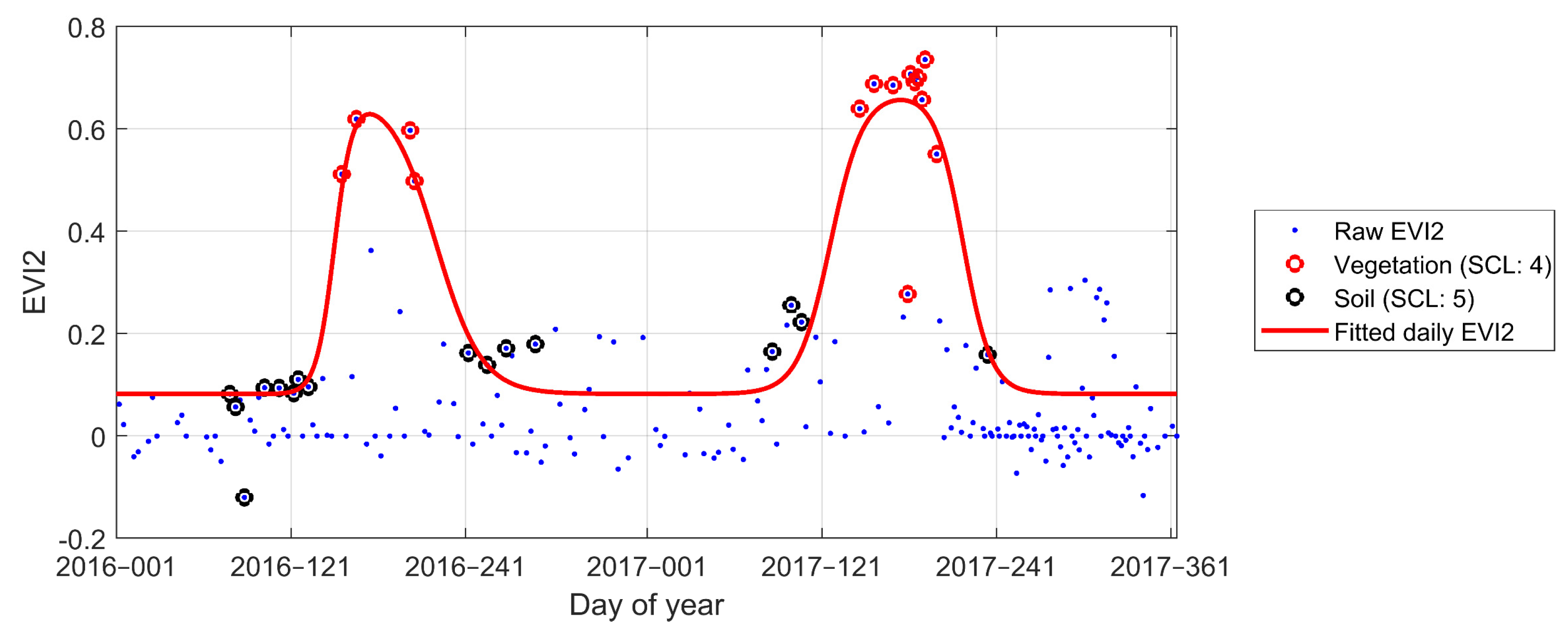
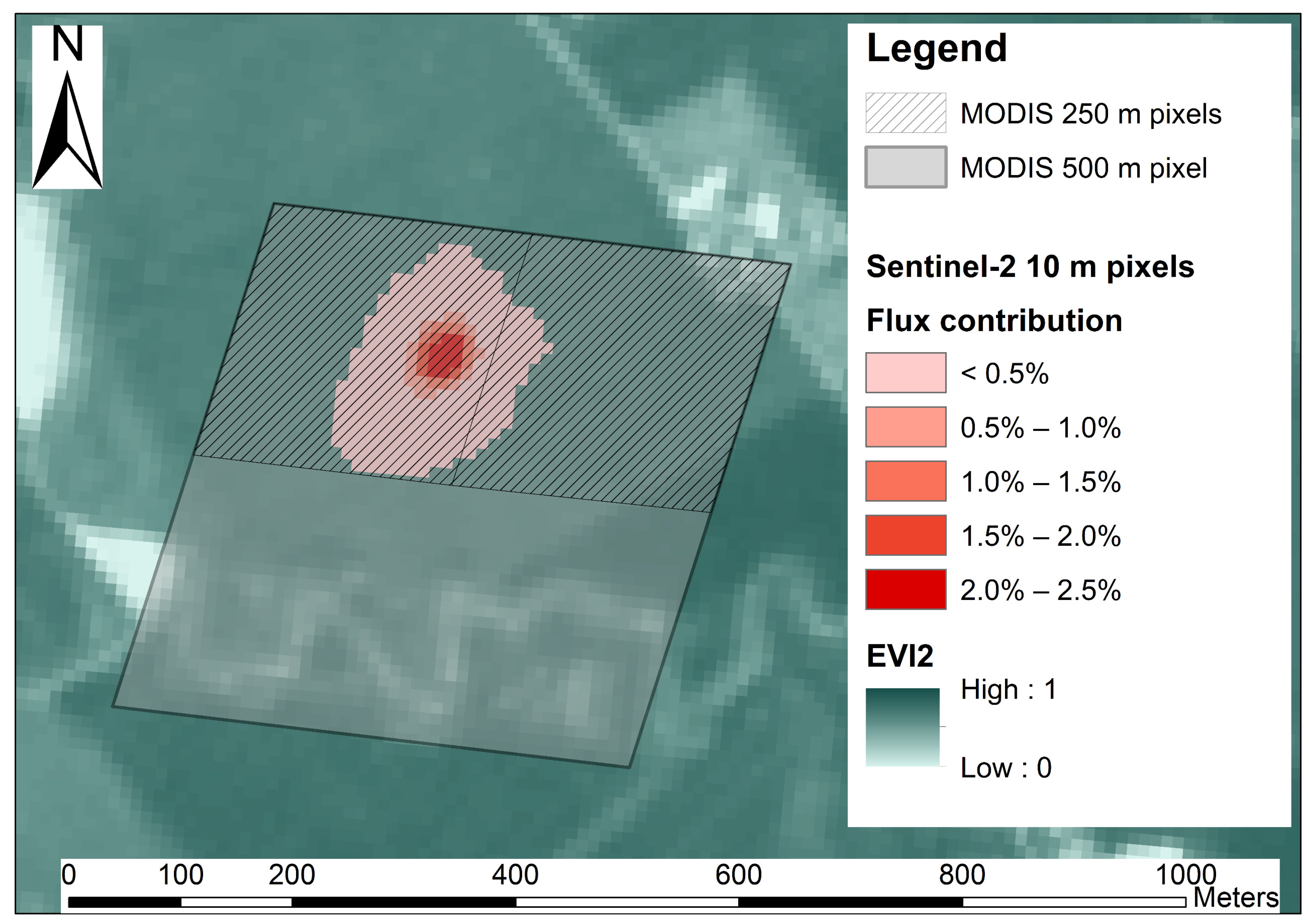
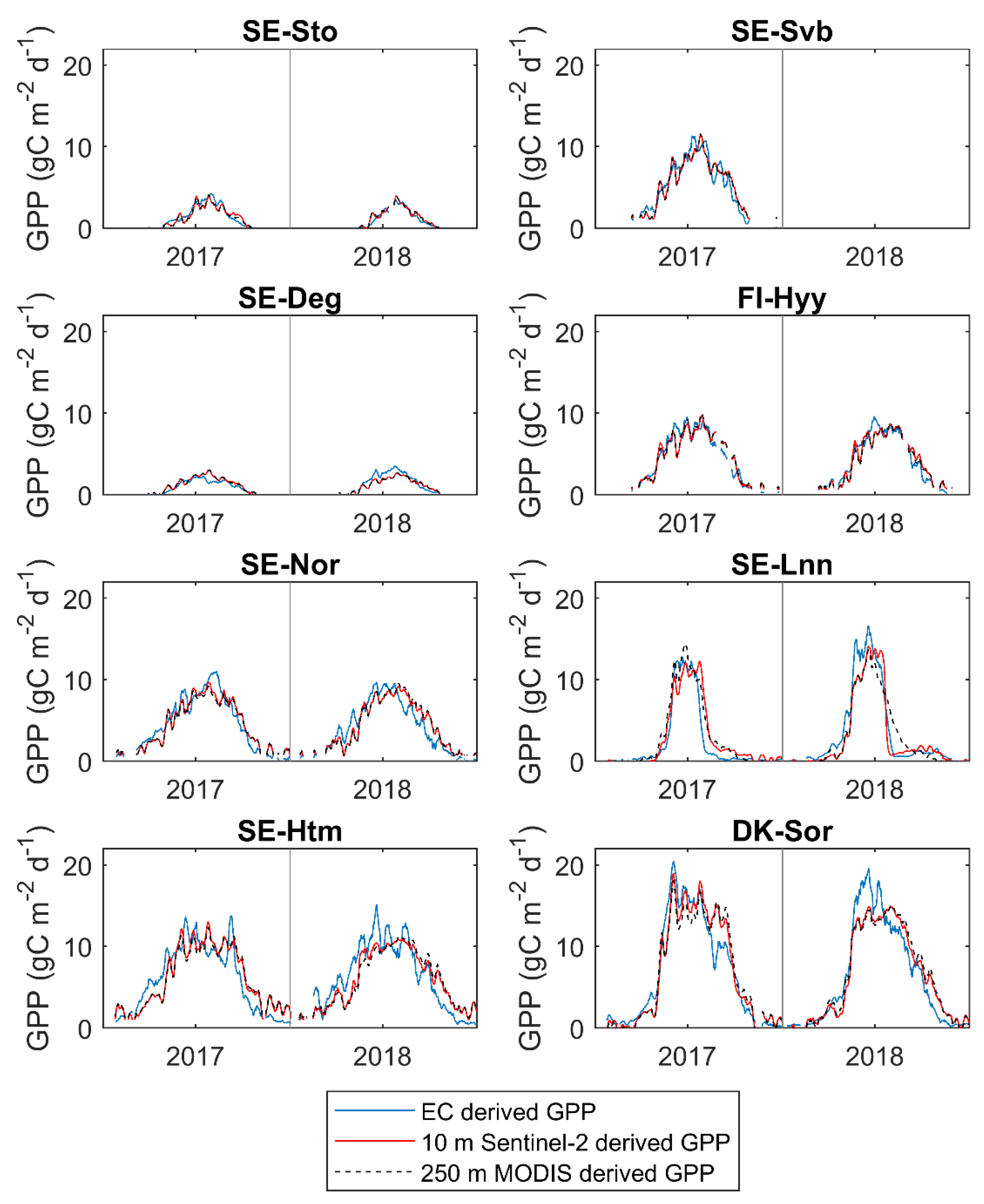
| Site Name | Site Name | Latitude (Degree) | Longitude (Degree) | Annual Average Ta (°C) 1 | Flux Measurement Height (m) | Biome/Vegetation |
|---|---|---|---|---|---|---|
| SE-Sto | Abisko-Stordalen | 68.36 | 19.05 | 0.5 | 2 | Subarctic mire |
| SE-Svb | Svartberget | 64.25 | 19.77 | 2.9 | 33 | Boreal mixed-evergreen forest: Scots pine (Pinus sylvestris) and Norway Spruce (Picea abies) |
| SE-Deg | Degerö | 64.18 | 19.55 | 2.0 | 2 | Boreal mire |
| FI-Hyy | Hyytiälä | 61.85 | 24.29 | 4.3 | 23 | Boreal evergreen forest: Scots pine (Pinus sylvestris) |
| SE-Nor | Norunda | 60.09 | 17.48 | 6.7 | 36 | Boreal evergreen mixed forest: Scots pine (Pinus sylvestris) and Norway spruce (Picea abies) |
| SE-Lnn | Lanna | 58.33 | 13.10 | 7.5 | 2 | Temperate agriculture |
| SE-Htm | Hyltemossa | 56.10 | 13.42 | 8.1 | 27 | Temperate evergreen forest: Norway spruce (Picea abies) |
| DK-Sor | Sorø | 55.49 | 11.64 | 8.7 | 43 | Temperate deciduous forests: Beech dominated (Fagus sylvatica) |
| EVI210m | EVI2250m | EVI2500m | Ta | PPFD | VPD | |
|---|---|---|---|---|---|---|
| SE-Sto | 0.77 | 0.81 | 0.83 | 0.69 | 0.04 | 0.24 |
| SE-Svb | 0.74 | 0.73 | 0.79 | 0.86 | 0.51 | 0.41 |
| SE-Deg | 0.59 | 0.58 | 0.63 | 0.68 | 0.28 | 0.34 |
| FI-Hyy | 0.73 | 0.83 | 0.86 | 0.87 | 0.54 | - |
| SE-Nor | 0.81 | 0.67 | 0.72 | 0.82 | 0.74 | 0.53 |
| SE-Lnn | 0.89 | 0.93 | 0.90 | 0.31 | 0.49 | 0.23 |
| SE-Htm | 0.78 | 0.45 | 0.56 | 0.75 | 0.82 | 0.43 |
| DK-Sor | 0.93 | 0.87 | 0.89 | 0.79 | 0.76 | 0.57 |
| Resolution | RMSE 1 | MAE 1 | R2 | |||
|---|---|---|---|---|---|---|
| SE-Sto | 10 m | 0.61 | −0.23 | 0.49 | 0.39 | 0.83 |
| 250 m | 0.60 | −0.17 | 0.45 | 0.35 | 0.86 | |
| 500 m | 0.69 | −0.13 | 0.44 | 0.35 | 0.86 | |
| SE-Svb | 10 m | 1.72 | 1.06 | 1.12 | 0.95 | 0.87 |
| 250 m | 1.77 | 1.09 | 1.10 | 0.94 | 0.88 | |
| 500 m | 1.71 | 1.20 | 1.04 | 0.88 | 0.89 | |
| SE-Deg | 10 m | 0.54 | 0.10 | 0.51 | 0.39 | 0.71 |
| 250 m | 0.42 | 0.13 | 0.52 | 0.40 | 0.69 | |
| 500 m | 0.42 | 0.12 | 0.51 | 0.40 | 0.70 | |
| FI-Hyy | 10 m | 1.34 | 0.61 | 0.98 | 0.73 | 0.89 |
| 250 m | 1.17 | 0.78 | 0.96 | 0.71 | 0.89 | |
| 500 m | 1.13 | 0.87 | 0.96 | 0.70 | 0.89 | |
| SE-Nor | 10 m | 1.28 | 0.63 | 1.27 | 1.02 | 0.84 |
| 250 m | 1.29 | 0.68 | 1.36 | 1.09 | 0.81 | |
| 500 m | 1.20 | 0.81 | 1.33 | 1.07 | 0.82 | |
| SE-Lnn | 10 m | 1.25 | −0.18 | 1.60 | 1.03 | 0.88 |
| 250 m | 1.23 | −0.68 | 1.60 | 1.19 | 0.88 | |
| 500 m | 1.23 | −0.71 | 1.96 | 1.43 | 0.82 | |
| SE-Htm | 10 m | 1.56 | 1.00 | 1.92 | 1.63 | 0.77 |
| 250 m | 1.39 | 1.24 | 2.13 | 1.83 | 0.72 | |
| 500 m | 1.25 | 1.50 | 2.09 | 1.81 | 0.73 | |
| DK-Sor | 10 m | 1.35 | −0.36 | 1.91 | 1.44 | 0.91 |
| 250 m | 1.52 | −0.81 | 2.19 | 1.68 | 0.88 | |
| 500 m | 1.54 | −0.84 | 2.12 | 1.63 | 0.88 |
| RMSE | MAE | R2 | ||||||
|---|---|---|---|---|---|---|---|---|
| 250 m | 500 m | 250 m | 500 m | 250 m | 500 m | |||
| 10 m | 0.547 | 0.313 | 10 m | 0.250 | 0.313 | 10 m | 0.461 | 0.461 |
| 500 m | 0.195 | - | 500 m | 0.250 | - | 500 m | 0.195 | - |
| Resolution | RMSE 1 | MAE 1 | R2 |
|---|---|---|---|
| 10 m | 1.23 | 0.95 | 0.84 |
| 250 m | 1.29 | 1.02 | 0.83 |
| 500 m | 1.31 | 1.03 | 0.82 |
Publisher’s Note: MDPI stays neutral with regard to jurisdictional claims in published maps and institutional affiliations. |
© 2021 by the authors. Licensee MDPI, Basel, Switzerland. This article is an open access article distributed under the terms and conditions of the Creative Commons Attribution (CC BY) license (http://creativecommons.org/licenses/by/4.0/).
Share and Cite
Cai, Z.; Junttila, S.; Holst, J.; Jin, H.; Ardö, J.; Ibrom, A.; Peichl, M.; Mölder, M.; Jönsson, P.; Rinne, J.; et al. Modelling Daily Gross Primary Productivity with Sentinel-2 Data in the Nordic Region–Comparison with Data from MODIS. Remote Sens. 2021, 13, 469. https://doi.org/10.3390/rs13030469
Cai Z, Junttila S, Holst J, Jin H, Ardö J, Ibrom A, Peichl M, Mölder M, Jönsson P, Rinne J, et al. Modelling Daily Gross Primary Productivity with Sentinel-2 Data in the Nordic Region–Comparison with Data from MODIS. Remote Sensing. 2021; 13(3):469. https://doi.org/10.3390/rs13030469
Chicago/Turabian StyleCai, Zhanzhang, Sofia Junttila, Jutta Holst, Hongxiao Jin, Jonas Ardö, Andreas Ibrom, Matthias Peichl, Meelis Mölder, Per Jönsson, Janne Rinne, and et al. 2021. "Modelling Daily Gross Primary Productivity with Sentinel-2 Data in the Nordic Region–Comparison with Data from MODIS" Remote Sensing 13, no. 3: 469. https://doi.org/10.3390/rs13030469
APA StyleCai, Z., Junttila, S., Holst, J., Jin, H., Ardö, J., Ibrom, A., Peichl, M., Mölder, M., Jönsson, P., Rinne, J., Karamihalaki, M., & Eklundh, L. (2021). Modelling Daily Gross Primary Productivity with Sentinel-2 Data in the Nordic Region–Comparison with Data from MODIS. Remote Sensing, 13(3), 469. https://doi.org/10.3390/rs13030469







